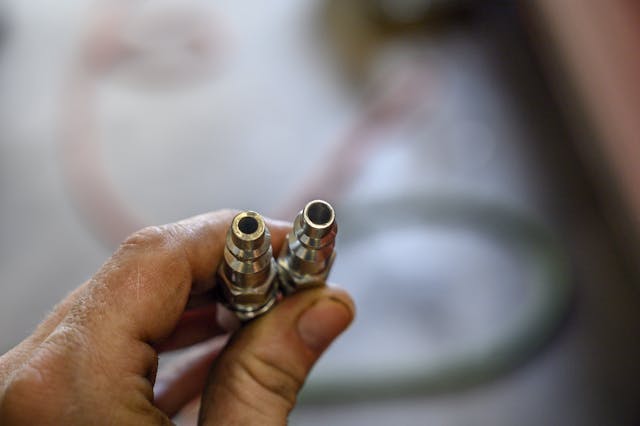Media | Articles
Wrenchin’ Wednesday: Free horsepower for your air tools
Air fittings are one of those things that you look at something on the shelf and wonder, “what’s the difference between the $1 and $10 part?” Often times, it’s just sticking to the general spec that you see on the box, like the 1/4-inch inner diameter of an air fitting. Most home air-compressors use 3/8-inch hose with 1/4-inch couplers, which are measured on their inner diameters. The male end of the quick disconnect coupler is what we’ll be working on today, though keep an eye out on how to spot a high-flow female coupler too.
The simple problem with the more commonly available air fittings brands is that they tend to have the smallest inner diameters, with cheaper brands drilling their fittings slightly undersized or even off-center to account for their looser tolerances and quality. In the same way it’s easier to hit a target that’s the size of a barn, under-sizing the hole makes the common air fitting quick and easy to mass produce.
The right move is to buy high-flow fittings from better brands, but if you’re working with what you have, here’s a time-tested porting project that’ll increase the inner diameter by as much as 20%. For me, the shop I rent has its air compressor about 100 feet from the shop space, so doing everything possible to mitigate pressure drop added up quickly for air-hungry tools like the impact gun and zip wheel — but until I re-tool every air drop and hose for larger fittings, porting serves to fill the gap.
Every air fitting will be different, so start by inserting different drill bits until you find one that perfectly fits the inner diameter of the coupler. This will serve as our base drill size.
Work up one drill size at a time, each step is a major change in inner diameter given how small of a space we’re working with. For these two hardware specials, the inner-diameter started at about .185 of an inch and I settled two drill sizes up at approximately .21 of an inch. There is a point at which you can go too far by either decreasing the wall thickness to the point of failure or until the pintle inside the female coupler essentially fall inside the ported hole, blocking it off.
Marketplace
Buy and sell classics with confidence

There are a few variations of pintles too, which will play into this. The upper photo shows the cheaper hardware store female coupler, which has a narrower pintle inside. This allowed the pintle to drop into the fitting, plugging it up — backing down one drill size sorted this problem in the short term until a different female coupler was found with a wider, hollow pintle (which was compatible with the over-drilled experimental fitting, too).
Eventually, the shop will be retooled for 1/2-inch air hose and 3/8-inch fittings, which will require a few plumbing changes to step the air drops up to the correct diameter, but the difference in air volume is monumental for only a few minutes of work porting each fitting.




















